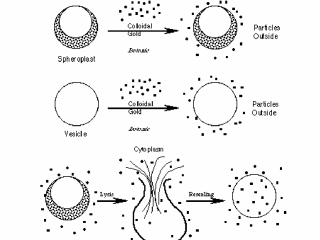 |
Figure 3. Formation of membrane vesicles by
osmotic lysis involves membrane rupture and resealing (i.e., the membrane
has the properties of a phospholipid bilayer): Top. Addition of colloidal
gold (visible in the electron microscope) to spheroplasts reveals gold
particles outside, none within. Middle. Same with membrane vesicles. Bottom.
Osmotic lysis of spheroplasts in the presence of colloidal gold leads to
vesicles with colloidal gold trapped inside. Therefore, release of
intracellular contents during lysis involves rupture of the plasma membrane
and resealing.
During lysis, the intracellular space equilibrates with the external medium.
Thus, in addition to emptying the cell of its soluble contents, during
lysis, large molecule such as enzymes or antibodies can be introduced into
the intravesicular space.
|
